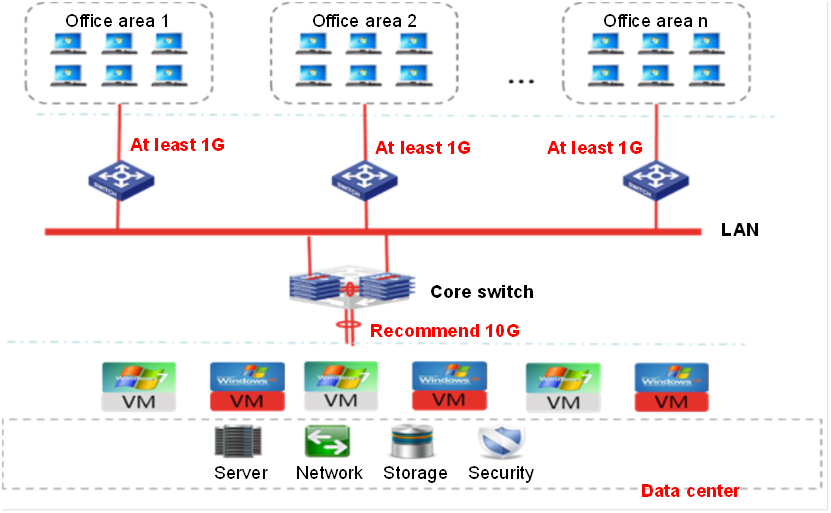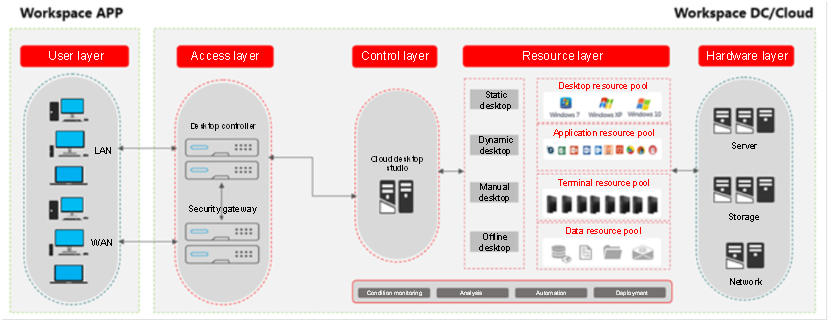Cloud Desktop Telecommuting Solution
Status of industry
With the development of mobile communications technologies and business models, more and more people choose telecommuting and mobile office. In this way, the enterprise can greatly reduce the operating expenses, increase employees' flexibility and efficiency, to improve the operation efficiency of the enterprise, and increase the profits of the enterprise.
With the growth of enterprises, the establishment of branch offices and the increase of remote employees, enterprises must open internal cloud desktops to meet the requirements of daily office work.
At present, H3C cloud desktop has been deployed in all walks of life. More and more customers use H3C cloud desktop technology to perform daily internal office work. With its advantages in overall costs, data security, stability, manageability, maintainability and energy consumption, cloud desktops have gradually replaced conventional PCs and become the mainstream mode in modern office.
Overall design scheme of cloud desktop
According to the current situation and demand analysis, and combined with typical cloud desktop solution, a modular, scalable and highly secure desktop cloud is formulated. Its overall architecture is as follows:

As shown above, in the solution, the flat deployment is adopted, that is, the cloud desktop resources in the cloud are centrally deployed in the data center (equipment room) of the carrier. The clients at the terminal are deployed in each office area, and the private network or Internet is used to ensure the bandwidth between cloud and terminal. The server systems are deployed in clusters under centralized management and control of the virtualization management platform. That is, all virtual resources such as VMs, hosts, and network hardware devices are visually displayed under one virtual data center. The data center topology diagrams can also be generated visually for unified external presentation and management.
The H3C Workspace cloud desktop solution relies on shared storage architecture to ensure data security and improve IO performance. With the underlying high-reliability settings, the continuity of office service is guaranteed. In case that a single physical host is down, the service can be quickly recovered.
The resource planning of the data center is same as that in the general office cloud desktop solution. The hyper-converged resource pool or separated storage/computing resource pools can be used according to customers' resources. The terminal on the user side is connected to the cloud desktop management platform on the cloud data center side in a secure gateway mode. The desktop resources are obtained and the cloud desktop is used for office. The cloud desktop architecture of a data center is mainly divided into five parts: A user layer, an access layer, a control layer, a resource layer, and a hardware layer.

Benefits of cloud desktop solution
![]() Uploading data for information security
Uploading data for information security
In a conventional desktop environment, user data is stored in a local PC, which has many internal disclosure paths and is prone to various network attacks, causing data loss. In a desktop cloud environment, a terminal is separated from data. The local terminal is just a display device with no local storage. All desktop data is stored in an enterprise data center in a centralized manner, and there is no need to worry about the leakage of corporate intellectual assets.
![]() Efficient maintenance for continuous service
Efficient maintenance for continuous service
The conventional desktop system has a high failure rate. According to statistics, a dedicated IT employee is required to manage and maintain 200 PCs. In addition, the maintenance flow (fault report -> arrange personnel for maintenance -> locate fault -> perform maintenance) of each PC takes 2 to 4 hours. The desktop cloud does not require front-end maintenance. The "one-click" maintenance tool makes the self-service maintenance easier and improves the operation efficiency of the enterprise. After using the desktop cloud, each IT employee can manage more than 2000 virtual desktops, which improves maintenance efficiency by more than 10 times. The average recovery time is reduced to 3 minutes, which effectively guarantees the continuity of services.
![]() Uploading applications for service security
Uploading applications for service security
In the conventional desktop environment, all services and applications are processed on the local PC. The stability is 99.5% and the annual downtime is about 21 hours. In the desktop cloud, all services and applications are processed in the data center. The powerful equipment room assurance system guarantees that the annual average availability of global services reaches 99.9%, fully ensuring service continuity. The stable operation of various applications effectively reduces the management and maintenance costs of the office environment.
![]() Seamless switchover for mobile office
Seamless switchover for mobile office
In a conventional desktop environment, users can only access their personalized desktops through a single dedicated device, which greatly limits the flexibility of the user's office space. With cloud desktops, the data and desktops are running in a centralized manner and stored in a data center. Therefore, users can switch office locations seamlessly without interrupting application running.
![]() Cooling and noise removal for green office
Cooling and noise removal for green office
Energy-saving and noise-free cloud terminals are deployed to effectively solve the temperature and noise issues in dense office environments. Cloud terminals reduce office noise from 50 decibels to 10 decibels, making office environments quieter. The total power consumption of the cloud terminal and the liquid crystal display is about 20W. The low energy consumption of the terminal can effectively reduce cooling expenses.
![]() Resource elasticity for multiplexing and sharing
Resource elasticity for multiplexing and sharing
In the environment of cloud desktop with resource elasticity, all resources are concentrated in a data center, to realize centralized management & control and elastic scheduling of resources. Centralized sharing of resources improves the utilization of resources. The average CPU utilization of a conventional PC is 5%-20%. In a cloud desktop environment, the CPU utilization of a cloud data center can reach 60%, which has improved the overall resource utilization.

